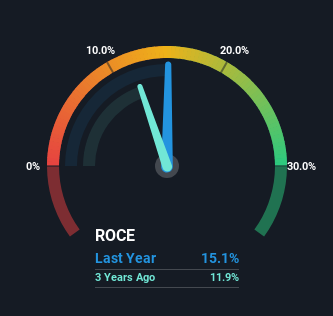Returns Are Gaining Momentum At Sanmina (NASDAQ:SANM)
What are the early trends we should look for to identify a stock that could multiply in value over the long term? Amongst other things, we'll want to see two things; firstly, a growing return on capital employed (ROCE) and secondly, an expansion in the company's amount of capital employed. Ultimately, this demonstrates that it's a business that is reinvesting profits at increasing rates of return. With that in mind, we've noticed some promising trends at Sanmina (NASDAQ:SANM) so let's look a bit deeper.
What Is Return On Capital Employed (ROCE)?
For those who don't know, ROCE is a measure of a company's yearly pre-tax profit (its return), relative to the capital employed in the business. Analysts use this formula to calculate it for Sanmina:
Return on Capital Employed = Earnings Before Interest and Tax (EBIT) ÷ (Total Assets - Current Liabilities)
0.15 = US$422m ÷ (US$4.6b - US$1.8b) (Based on the trailing twelve months to December 2023).
Thus, Sanmina has an ROCE of 15%. In absolute terms, that's a satisfactory return, but compared to the Electronic industry average of 12% it's much better.
See our latest analysis for Sanmina
Above you can see how the current ROCE for Sanmina compares to its prior returns on capital, but there's only so much you can tell from the past. If you'd like to see what analysts are forecasting going forward, you should check out our free analyst report for Sanmina .
So How Is Sanmina's ROCE Trending?
The trends we've noticed at Sanmina are quite reassuring. The numbers show that in the last five years, the returns generated on capital employed have grown considerably to 15%. The amount of capital employed has increased too, by 60%. The increasing returns on a growing amount of capital is common amongst multi-baggers and that's why we're impressed.
On a related note, the company's ratio of current liabilities to total assets has decreased to 39%, which basically reduces it's funding from the likes of short-term creditors or suppliers. This tells us that Sanmina has grown its returns without a reliance on increasing their current liabilities, which we're very happy with.
Our Take On Sanmina's ROCE
A company that is growing its returns on capital and can consistently reinvest in itself is a highly sought after trait, and that's what Sanmina has. Since the stock has returned a solid 87% to shareholders over the last five years, it's fair to say investors are beginning to recognize these changes. In light of that, we think it's worth looking further into this stock because if Sanmina can keep these trends up, it could have a bright future ahead.
If you want to continue researching Sanmina, you might be interested to know about the 1 warning sign that our analysis has discovered.
While Sanmina may not currently earn the highest returns, we've compiled a list of companies that currently earn more than 25% return on equity. Check out this free list here.
Have feedback on this article? Concerned about the content? Get in touch with us directly. Alternatively, email editorial-team (at) simplywallst.com.
This article by Simply Wall St is general in nature. We provide commentary based on historical data and analyst forecasts only using an unbiased methodology and our articles are not intended to be financial advice. It does not constitute a recommendation to buy or sell any stock, and does not take account of your objectives, or your financial situation. We aim to bring you long-term focused analysis driven by fundamental data. Note that our analysis may not factor in the latest price-sensitive company announcements or qualitative material. Simply Wall St has no position in any stocks mentioned.

 Yahoo Finance
Yahoo Finance 
